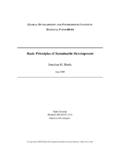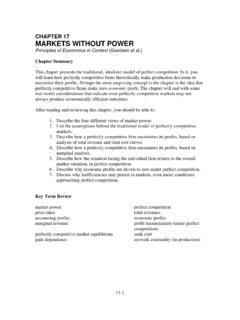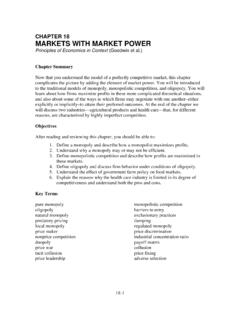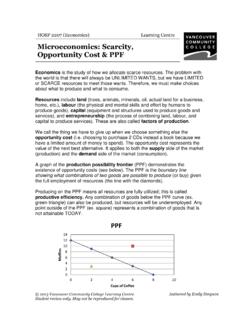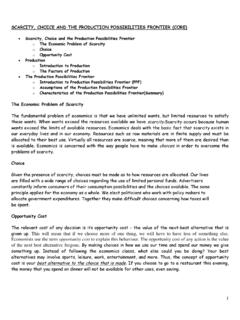Transcription of Chapter 2 Useful Tools and Concepts - Tufts University
1 2-1 Chapter 2 Useful Tools and Concepts Macroeconomics in Context (Goodwin, et al.) Chapter Overview This Chapter introduces standard Concepts of economic modeling, efficiency, scarcity , opportunity cost, the production possibilities Frontier, and the advantages of market systems, and includes a review of graphing techniques. In this Chapter you will see these Concepts set into a broader context of concern for well-being. The Chapter discusses the institutional requirements of markets and introduces the Concepts of externalities, public goods, market power, transaction costs, information and expectations and concern for human needs and equity in order to demonstrate why markets, while Useful , are not on their own sufficient for organizing economic life in the service of well-being. Chapter Objectives After reading and reviewing this Chapter , you should be able to: 1.
2 Distinguish and differentiate among the different methods of investigation: empirical investigation, theoretical investigation, and historical investigation. 2. Understand the concept of economic tradeoffs (or opportunity costs) in the face of abundance or scarcity . 3. Interpret and apply the production possibilities Frontier. 4. Distinguish the different meanings of the term market, and describe how the market is understood in the basic neoclassical model. 5. Describe the institutional requirements of markets. 6. Identify the advantages and limitations of markets. Key Terms empirical investigation time series data negative (or inverse) relationship positive (or direct) relationship theoretical investigation model ceteris paribus historical investigation abundance scarcity production possibilities frontier opportunity cost efficiency technological progress market institutions basic neoclassical (traditional microeconomic)model private property implicit contract explicit contract physical infrastructure public goods free riders 2-2 externalities transactions costs market power static analysis dynamic analysis market failure Active Review Fill in the Blank 1.
3 The observation and recording of specific phenomena of concern is called _____ investigation, whereas the analysis based in abstract thought is called _____ investigation. 2. When researchers study past events, they are conducting a(n) _____ investigation. 3. The Latin phrase that means all else constant or other things equal is _____. 4. A diagram that shows the tradeoffs between production of two goods is called a(n) _____. 5. You re deciding whether to take an Economics course, or to take an Anthropology course. The _____ cost of taking the Economics course is the course you re having to forego, the Anthropology course. 6. A process that achieves the maximum value of output from the given set of inputs can be described as _____. 7. If someone enjoys the benefit of a well-paved highway but refuses to pay for it, they would be considered a _____.
4 8. You decide to buy a used car. You discover that it is hard to get information on the quality of the used cars that are available. You have trouble communicating with the car dealer. It takes a considerable amount of time to get the information you need to successfully get the car you had in mind. In other words, buying a used car turns out to be an activity with high _____ costs. 9. A new factory begins discharging pollutants into a previously pristine river. Fish in the river begin to die, and people who make their living through fishing have trouble maintaining their catch. This factory is generating negative _____. 10. A professional musician practices piano every afternoon. Her neighbor listens to the music and enjoys it. Through her activity, the musician is creating a positive _____. 2-3 True or False Questions 11 to 13 refer to the production possibilities frontier shown below.
5 AQuantity of ButterQuantity of GunsBDC50 100120300 11. In the graph shown above, at point B, society is producing the maximum possible amount of butter. 12. To move from point A to point B, society would have to cut down on its gun production and increase butter production . 13. Starting from point B, society would have to shift substantial resources to increase gun production . 14. A public good is a good that is consumed by the public. 15. Public goods, externalities, transactions costs, market power, the difficulty of getting information, and concern for human needs and equity are all examples of issues that lead to market failure. Short Answer 16. Assume you see that two macroeconomic variables are correlated with each other. But you want to know if there s an underlying or causal relationship between the two variables. Would you use an empirical or theoretical investigation?
6 Explain why. 2-4 17. Why does a production possibilities frontier with increasing opportunity costs have a bowed-out shape? 18. Consider the following PPF: AQuantity of ButterQuantity of GunsBDC50 100120300 Identify points that are a) inefficient and b) unattainable. How might a country be able to produce a combination of goods and services that was otherwise unattainable? 19. Consider the following production /Maintenance frontier. 2-5 What would the future PPF look like if a high level of resource maintenance ( point B) were chosen now? If a high level of resource depleting production ( point A) were chosen now? 20. Provide an example of a market that fits the first meaning of markets (as a physical place), and an example of a market that fits the second definition (as an institution). 21. Name the two actors in the basic neoclassical (or traditional microeconomic) model of economics, and identify the assumptions the model makes of these two actors.
7 22. What does the basic neoclassical, or traditional, model of economics assume about markets? 23. List two advantages of markets identified by the authors of the text. 24. Identify the four institutional requirements of markets. 25. Identify six disadvantages of markets ( cases of market failures). 2-6 Problems 1. Given the following data: Year Unemployment Rate (percent) Inflation Rate (percent per year) 1984 1985 1986 1987 Source: Economic Report of the President a. Plot the unemployment data on a time series graph: B.
8 Plot the inflation data on a time series graph: b. Now plot the unemployment and inflation data using a scatter diagram. Over any period of years is there a positive relationship between the two variables? Over any period is there a negative relationship? 2-7 2. Suppose that a society could produce the following maximum combinations of schools and airplanes in a given year: Alternative Quantity of schools Quantity of airplanes A 100 0 B 80 30 C 60 50 D 40 60 E 20 65 F
9 0 68 a. Draw a production possibilities frontier (PPF) with schools on the horizontal axis and airplanes on the vertical axis. Assume that the dots define a complete curve. b. Is it possible and/or efficient for this society to produce 50 airplanes and 80 schools? c. If society is currently producing at alternative C, then the opportunity cost of increasing the output of schools from 60 to 80 is _____ airplanes. d. If society is currently producing at alternative E, then the opportunity cost of increasing the output of schools from 20 to 40 is _____ airplanes. e. Is the opportunity cost of producing schools higher or lower moving from alternative C to B, than moving from E to D? Explain why. 2-8 Self Test 1. Suppose an investigator has 50 years of data on rates of industrial production and annual accumulations of CO2, and discovers a positive relationship between the two variables.
10 This is an example of what type of investigation? a. Theoretical investigation b. Empirical investigation c. Historical investigation d. Both A and B. e. A, B, and C. 2. What does the production possibilities Frontier represent? a. A catalog of all possible production options, represented as percentages. b. The tradeoffs between production and consumption options. c. The tradeoffs between possible production levels for two goods. d. The amount that a society could produce if it devoted all its resources to producing one good. e. The possible gains from international trade in two or more goods. 3. Which of the following factors could expand a society s production possibilities frontier? a. Increased butter production . b. Shifting from one product to another. c. Producing air pollution. d. Depleting resources now instead of later. e. Technological innovations.




